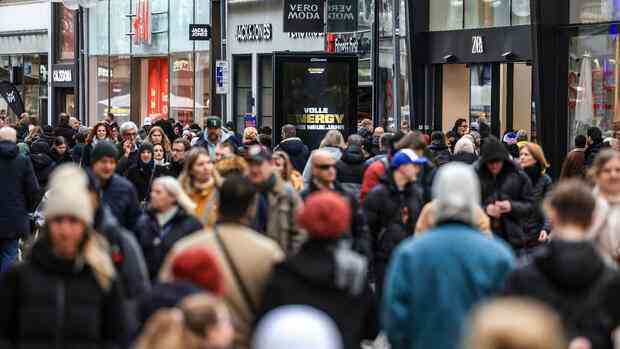According to the barometer, consumers’ propensity to buy has increased.
(Photo: dpa)
Dusseldorf Germany’s consumers seem to be gradually coming to terms with the crisis, inflation and rising interest rates. This is signaled by the HDE consumption barometer, which at 91.93 points in February has reached the level it was before the outbreak of the Ukraine war for the first time. At that time, the leading indicator plummeted in the months after the start of the war and reached its low in October 2022. The consumption barometer has been climbing again for four months now.
The leading indicator is made up of several sub-indices that are included in the overall value according to their importance. There were very strong jumps in income expectations for the current February and the propensity to buy for the coming months; concerns about inflation eased noticeably. At the same time, consumers are planning to put more money on the back burner again. In addition, rising interest rates dampened the mood slightly.
The survey of around 1,600 representative households took place in mid-January. The consumption barometer is calculated monthly by the Handelsblatt Research Institute (HRI) for the trade association HDE.
One reason for the improved consumer mood is likely to be the predominantly good macroeconomic reports since the beginning of the year. The Ifo business climate recently climbed for the fourth time in a row and the ZEW economic expectations were positive for the first time since February 2022. Economics Minister Robert Habeck (Greens) revised his economic forecast for the current year upwards to 0.2 percent growth.
For 2023, the HRI sees a slight increase in private consumption. After 7.9 percent in 2022, inflation is likely to fall to around five percent this year on average – the real loss of purchasing power is slowing down, but it is continuing. However, the federal government is counteracting this loss of purchasing power with aid packages and energy price brakes. Overall, state aid should probably absorb around two-thirds of the loss of purchasing power in the current year.
>> Read here: Purchasing power of collectively agreed employees fell by 4.7 percent – and thus more than ever
The most important pillar of consumption remains the robust labor market. Seasonally adjusted unemployment fell slightly in January. Compared to the same month last year, however, it was 154,000 people higher at 2.61 million. A major reason for this is that refugees from Ukraine have to register as unemployed in order to receive social benefits.
The major collective bargaining negotiations in the coming months are likely to have a major impact on consumer sentiment as the year progresses. For example, the Verdi union is demanding a 10.5 percent wage increase for public sector employees and a 15 percent increase for post office workers.
If the expectations raised by the unions are disappointed, this could have a negative impact on consumer sentiment. If, as was the case recently in industry, there were only moderate percentage wage increases plus high one-off tax and duty-free “inflation compensation premiums”, the employees would largely be left with the consequences of the surge in inflation for the long term.
>> Read here: When will consumer electricity prices drop?
Experts such as the head of the Federal Network Agency Klaus Müller are also warning of a possibly harsher next winter with corresponding effects on the energy supply. And the Harvard economist Kenneth Rogoff recently said in an interview with the Handelsblatt that he was still counting on a recession in Germany and Europe.
More: German economy on the brink of recession
